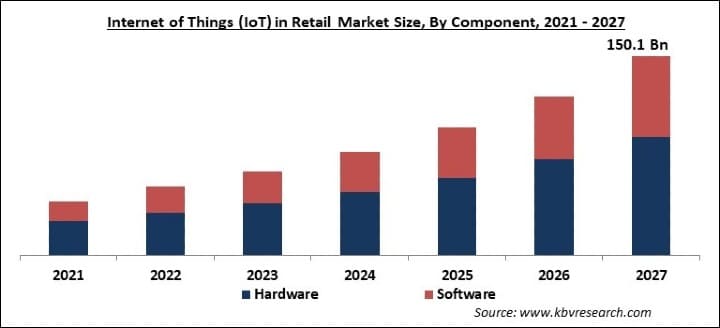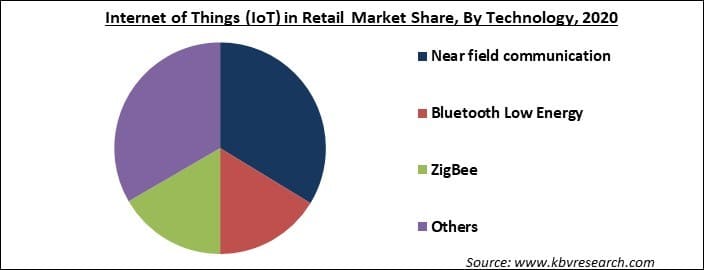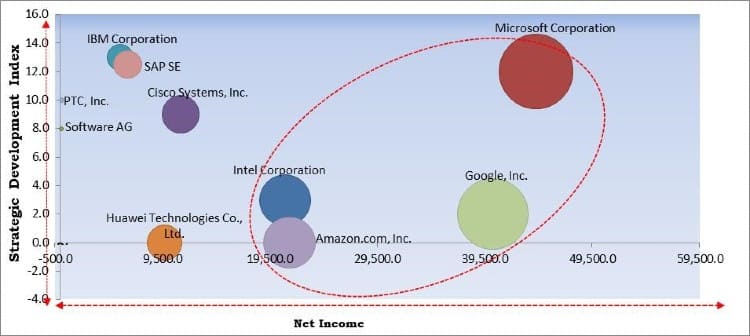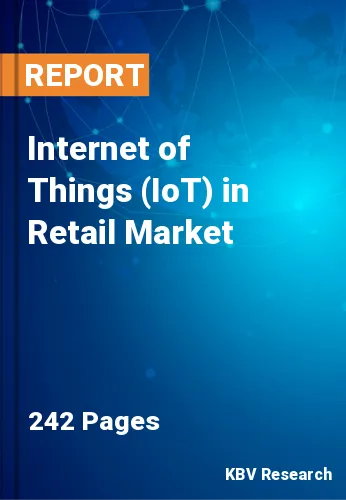The Global Internet of Things (IoT) in Retail Market size is expected to reach $150.1 billion by 2027, rising at a market growth of 24.2% CAGR during the forecast period. Internet of Things devices assist with the back-end operations of retailers like planning efficient logistics operations. The IoT-connected sensors, RFID tags, and GPS trackers monitor the passage of goods in real-time, offerings an effortless supply chain management. It further helps in preventing damage, spoilage, or loss of goods while transportation, which is mostly helpful for perishable food items.
The real-time data of traffic conditions, weather, and speed of vehicles promote intelligent logistics operation. In addition, aspects like decreased human errors, reduced overstocking & lack of products, efficient inventory management, and monitoring over storage conditions are contributing to the rising demand for IoT devices in retail warehousing.
IoT provides retailers an opportunity to create an enhanced ecosystem, which links the digital & physical worlds. The majority of retailers are experiencing the benefits of the broad variety of connected products by implementing an integration platform. Additionally, smart devices decrease the purchasing time of customers and offer an effortless shopping experience. There are some retailers who are gradually developing to discover the unique methods to connect with smart devices like smartphones and smartwatches for improving the in-store experience.

Various IoT solutions such as RFID tags & GPS sensors, which are utilized by retailers to gain an extensive picture related to the transportation of goods from manufacturing to a store to when a customer purchase it. The gathered data like the time required for transportation or the temperature at which the product needs to be stored could be evaluated in real-time.
This information is very useful, particularly during the transportation of perishable items, in which temperature storage plays an important role. As per the experts, generally three-quarters of retailers strategize to streamline their supply chain management with IoT solutions. Thus, this improvement in the supply chain management motivates retailers to adopt IoT in retail stores, which would further augment the market growth.
The global COVID-19 pandemic has affected the global IoT spending that also includes the retail industry. There are various new projects that have been put on hold by the retailers because their main focus was on the survival of business operations in this economic crisis. In addition, the technology plans for IoT that has been deferred by the enterprises owing to remote working restrictions. Due to this, the IoT in the retail market has showcased a slowdown in demand during the global pandemic crisis.
Though, the adoption of IoT in the retail sector is anticipated to slowly rise during the recovery phase. There are many retailers that are now deploying autonomous cleaning robots, contactless checkout kiosks, and mobile payment systems, to minimize human interference and curb the spread of the coronavirus. However, in the recovery phase of the pandemic, cloud services, AI technology, and automation are projected to empower the retail sector in the coming years.
Based on Component, the market is segmented into Hardware and Software. By solution, the hardware segment dominated the market with the largest revenue share in 2020. The increase in the number of interlinked devices in retail stores and the reduction in the prices of IoT sensors are anticipated to fuel the segment growth.
The supportive government initiatives and requirements to adopt IoT technology for improving productivity, boost stock efficiencies, and automatize supply chains are motivating retailers to implement hardware components. The commitment of the retailers to IoT innovation is also propelling the growth of connected devices that include RFID tags and beacons. Hardware Segment is further bifurcated across RFID Tags, Sensors, Beacons and Others.

Based on Technology, the market is segmented into Near field communication, Bluetooth Low Energy, ZigBee and Others. In the beginning, Bluetooth Low Energy (BLE) achieved a significant attraction because it enables the development of single-mode chips that can be utilized in low-cost battery-powered devices. This technology may impact various factors of the retail customer experience. In addition, this technology enables store check-in & intelligent interaction simpler to deploy in terms of payment. Retail giants like Target, Urban Outfitters, and Macy's have implemented Bluetooth beacons at their stores a long time back.
| Report Attribute | Details |
|---|---|
| Market size value in 2020 | USD 30.9 Billion |
| Market size forecast in 2027 | USD 150.1 Billion |
| Base Year | 2020 |
| Historical Period | 2017 to 2019 |
| Forecast Period | 2021 to 2027 |
| Revenue Growth Rate | CAGR of 24.2% from 2021 to 2027 |
| Number of Pages | 242 |
| Number of Tables | 364 |
| Report coverage | Market Trends, Revenue Estimation and Forecast, Segmentation Analysis, Regional and Country Breakdown, Competitive Landscape, Companies Strategic Developments, Company Profiling |
| Segments covered | Component, Technology, Region |
| Country scope | US, Canada, Mexico, Germany, UK, France, Russia, Spain, Italy, China, Japan, India, South Korea, Singapore, Malaysia, Brazil, Argentina, UAE, Saudi Arabia, South Africa, Nigeria |
| Growth Drivers |
|
| Restraints |
|
Based on Regions, the market is segmented into North America, Europe, Asia Pacific, and Latin America, Middle East & Africa. Region-wise, North America emerged as a leading region in the IoT in the retail market with a significant revenue share in 2020. The growth of the e-commerce segment in the region has created problems for the departmental stores regarding making improved & advanced business operations. Additionally, the growth of this region is attributed to the robust research & development abilities of key players like Google LLC, IBM Corporation, Intel Corporation, Microsoft Corporation, and PTC Inc. Google introduced a pilot project named Project Beacon in 2018 and begun sending free beacons to physical shops or stores.

Free Valuable Insights: Global Internet of Things (IoT) in Retail Market size to reach USD 150.1 Billion by 2027
The major strategies followed by the market participants are partnerships. Based on the Analysis presented in the Cardinal matrix; Microsoft Corporation, Intel Corporation, Amazon.com, Inc., and Google, Inc. are the forerunners in the Internet Of Things in Retail Market. Companies such as IBM Corporation, PTC, Inc., and Software AG are some of the key innovators in the market.
The market research report covers the analysis of key stake holders of the market. Key companies profiled in the report include Cisco Systems, Inc., IBM Corporation, Intel Corporation, Microsoft Corporation, PTC, Inc., Huawei Technologies Co., Ltd. (Huawei Investment & Holding Co., Ltd.), Amazon.com, Inc., SAP SE, Software AG, Google, Inc.
By Component
By Technology
By Geography
The global Internet of Things (IoT) market size is expected to reach $150.1 billion by 2027.
Improved supply chain management are driving the market in coming years, however, lack of proper infrastructure have limited the growth of the market.
Cisco Systems, Inc., IBM Corporation, Intel Corporation, Microsoft Corporation, PTC, Inc., Huawei Technologies Co., Ltd. (Huawei Investment & Holding Co., Ltd.), Amazon.com, Inc., SAP SE, Software AG, Google, Inc.
The expected CAGR of the Internet of Things (IoT) market is 24.2% from 2021 to 2027.
Yes, however, in the recovery phase of the pandemic, cloud services, AI technology, and automation are projected to empower the retail sector in the coming years.
The near field communication (NFC) segment garnered the highest market share in 2020.
Our team of dedicated experts can provide you with attractive expansion opportunities for your business.

